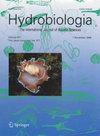Espíritu圣托群岛的中胚层生态系统作为气候变化的避难所
IF 0.3
4区 生物学
Q4 MARINE & FRESHWATER BIOLOGY
引用次数: 0
摘要
背景。沿海环境,如潮间带、岩石和珊瑚礁,容易受到自然干扰,如潮汐、风暴、飓风和旋风,以及人类活动,如捕鱼、旅游和污染。深礁避难假说认为,能够栖息在更深处的生物不太容易受到人为影响、海洋表面温室效应变暖以及二氧化碳分压增加引起的海洋酸化。因此,深层岩石或珊瑚礁可以作为抵御气候变化影响的“保险”。目标。分析Espíritu Santo群岛中生态系统的生物和非生物变量,以评估其作为气候变化相关干扰的避难所。方法。测深、温度、盐度和溶解氧剖面;测定光带,在浅水和深水中取样,收集用于分析碳酸盐系统的水,用远程操作车辆进行视频样带,以识别底栖生物物种并估计其丰度,包括那些具有商业重要性或保护意义的物种。生态指数和珊瑚礁功能指数的计算。结果。最深记录点78m,最浅中孔带11m。温度在2021年4月和10月均未出现分层现象,但盐度在30 m附近达到峰值,溶解氧在20 m处下降。W文石低于3.0;底栖生物群落结构指数存在空间差异,珊瑚礁功能指数在0.16 ~ 0.65之间。结论。在同一地点存在明显的空间差异,限制了中生态系统可以作为气候变化避难所的主张。本文章由计算机程序翻译,如有差异,请以英文原文为准。
The mesophotic ecosystem of archipelago Espíritu Santo as a refuge from climate change
Background. Coastal environments such as the intertidal zone and rocky and coral reefs are exposed to natural disturbances such as tides, storms, hurricanes, and cyclones and human activities such as fishing, tourism, and pollution. The deep reef refuge hypothesis posits that organisms that can inhabit greater depths would be less vulnerable to anthropogenic impacts, greenhouse warming of the sea surface, and ocean acidi-fication caused by the increased partial pressure of CO2. Consequently, deep rocky or coral reefs can function as “insurance” against the effects of climate change. Objective. To analyse biotic and abiotic variables of the mesophotic ecosystem of Archipelago Espíritu Santo to assess it as a refuge against climate change-related disturbances. Methods. Bathymetry, profiles of temperature, salinity, and dissolved oxygen; determination of the euphotic zone, sampling in shallow and deep waters collecting water for analysis of carbonate system, video transects with remotely operated vehicles for the identification of benthic species and estimation of their abundance including those of commercial importance or conservation. Calculation of ecological indices and the reef-functional index. Results. Deepest recorded point was 78m, shallowest mesophotic zone was 11m. Temperature does not show a stratification either in April or in October 2021, but the salinity registers a peak near 30 m depth, and the dissolved oxygen decreases at 20 m. W Aragonite is below 3.0; there is spatial variation in the structural indices of the benthic community, and the reef-functional index is between 0.16 and 0.65. Conclusions. There are sharp spatial variations within the same locality, limiting the assertion that mesophotic ecosystems can serve as a refuge from climate change.
求助全文
通过发布文献求助,成功后即可免费获取论文全文。
去求助
来源期刊

Hidrobiologica
生物-海洋与淡水生物学
CiteScore
0.40
自引率
0.00%
发文量
8
审稿时长
>12 weeks
期刊介绍:
HIDROBIOLÓGICA es una publicación cuatrimestral que difunde trabajos originales e inéditos de investigación o revisión, sobre temas relacionados con los organismos y la hidrología de los ambientes acuáticos, dulces y marinos y va dirigida a investigadores de todo el mundo, interesados en las diversas disciplinas que incluye la Hidrobiología , así como a alumnos de posgrados y licenciaturas relacionados con la biología, ecología, taxonomía, filogenia y evolución de organismos acuáticos, e hidrología y oceanografía de ambientes s dulceacuícolas y marinos.
 求助内容:
求助内容: 应助结果提醒方式:
应助结果提醒方式:


